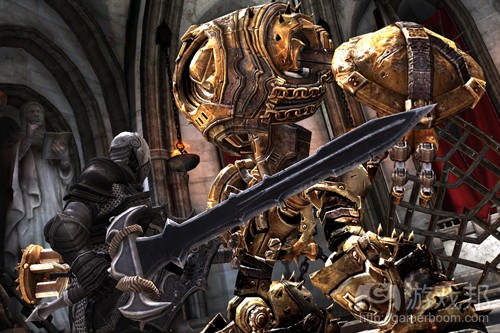阐述手机游戏的发展现状与未来趋势
作者: Shawn Foust
我知道,手机游戏是与社交游戏截然不同的领域,早期游戏可以在这些平台间成功移植并不代表未来仍可保持这一趋势。这些平台具有本质上的不同,在我看来,不同属性的平台衍生了不同类型的游戏。
移动设备的独特性
三大特性:移动性、屏幕面积以及输入方式。手机移动性的优势在于,它是第一个可以随处携带的游戏系统。其屏幕面积重新定义了用户玩游戏所适应的屏幕大小问题,输入方式则以触控为主。这些都是设计中的重要有效约束条件,如果开发者忽视了这一点,就将陷入不利境地。
我钟爱手机的移动性,它是一项重要变革。在此之前,人们在清醒状态下只有一小部分时间用来玩游戏。但移动性改变了这一情况,现在人们可以随时随地玩游戏。现在由于玩家每天都会碰上一些琐碎事件,所以我们无法要求用户延长同游戏互动的时间。这给予游戏设计一些启示(游戏邦注:例如缩短每回合游戏时长,允许玩家自由退出或进入游戏),但这只是让游戏向大众普及所需付出的一点小代价。如果游戏接受用户的这些使用习惯,并以此展开设计则可能收获更大的发展机遇。
手机游戏面临的一个主要问题就是屏幕面积。我认为,推行手机/社交跨平台体验的开发者应该一开始就根据移动设备特点来设计游戏,这样可以节省开发者事后投入的精力。不要在手机屏幕上设置多余的按键,没有哪一款手机屏幕能够呈现大量按钮。毕竟4英寸的手机屏幕与PC社交游戏的17英寸显示器,或者主机游戏的50英寸电视屏幕的体验效果完全不一样。
点触就是手机游戏的主要控制方式。这是游戏领域尚未挖掘的发展机遇。所有手机游戏都使用触屏,但其互动的方式千篇一律。大多数的游戏只需点击,而一些游戏需要在屏幕上划过(比如《水果忍者》),但游戏设计对这一领域的探索还不够深入。这方面较有进展的典型例子是《无尽之剑》中更为复杂的划屏动作。在我看来,触碰比电脑键盘上的方向键更具动感,就像电脑上的方向键比手机键盘更动态。但我认为这些属性并未体现在多种游戏中,这一点真是不可思议。
除了上述主要考虑,手机游戏设计还有另一个需要考虑的二级特性。我是地理定位游戏的忠实粉丝,我认为利用人们所在地理位置设计游戏是一个很有趣的发展方向。另外,加速器以及声音输入这些也是我们可以考虑的设计要素。这些特性是手机平台所独有的(除了在Xbox360上的Kinect技术,其他平台还未出现这些功能)。目前,所有这些功能还没有在手机游戏中普及。
所以,为何我们的手机游戏不充分利用这些优势呢?
学习过程
这些年我目睹了一个平台令开发者及用户由陌生到熟悉的过程。开发者没有足够的时间在他们的设计中体现这些附加变量,也没有成功使用这些元素的游戏案例可供借鉴。我们极少见到,这类游戏问世后马上就衍生出一些以此为基础的亚类游戏。看到《愤怒的小鸟》大获成功,我并不惊讶其简单的触碰机制会成为手机领域的主流(游戏邦注:《水果忍者》、《Tiny Wings》等也属于这种类型)。设计毕竟是一个迭代的过程,而创新型的游戏常常会受到开发者、评论家和玩家的质疑。
而且,成功的手机游戏并不一定需要采用专门针对移动设备的机制。我也怀疑用户并不需要更复杂的手机游戏机制。人们需要一定时间来适应不同风格的游戏玩法,一次性呈现过多内容反而会给用户造成困惑。另外如果让玩家一边使用复杂的划动控制方式,一边以声音控制方式来体验基于地理定位的战斗游戏,这种做法也未免古怪了一点,但未来可能就不一样了。要知道,游戏行业历时20年才从1个操作杆、一个按钮进入双摇杆、8个按钮的时代。
展望未来
我想说,现在流行的游戏在今后5年仍然炙手可热的可能性并不大。因为平台及开发者会持续迭代。将来人们终会发现并使用独特的手机功能创建成功的游戏机制。《无尽之剑》等游戏就是这一领域的先驱。相信随着游戏移动化的发展,我们终会见识到不同平台间的巨大差距性。(本文为游戏邦/gamerboom.com编译,拒绝任何不保留版权的转载,如需转载请联系:游戏邦)
Mobile Games: Today and Tomorrow
by Shawn Foust
Despite Jamil’s unwillingness to take the bait on my last article on Designing for the Social Platform, I’m gonna go ahead and talk about mobile. I’m of the mind that these are fundamentally different opportunities, and that early successes in porting between these platforms are unlikely to be sustained into the future. That doesn’t mean it isn’t good business today, but I’ll be a bit surprised if that’s the case in 3 years.
Why? Because the platforms are extraordinarily different in nature. It seems to me that platforms with different elements would breed different forms of game.
The Unique Aspects of Mobile
Three major ones: mobility, real estate and input. Mobility is pretty clear – this is the first gaming system you’re REQUIRED to carry with you everywhere. Real estate addresses the size of the screen a player has to work with and input refers to touch, the somewhat unique means information is delivered from user to device. Both of these are important and active constraints on design, and one ignores them at their own peril.
I love mobility, it’s a total game changer. Before a game developer was forced to accept that only a small portion of a person’s waking hours could be reasonably dedicated to games.
Mobility changes all of that. Since the game is present with the person at all times, the opportunity to game is always there. Now, it comes at a tradeoff. It’s very hard to demand prolonged interaction with the game because the use case calls for sporadic spurts throughout the day. That has implications for game design (sessions will probably need to be short and permit ingress and egress without repercussion), but that’s a small price to pay for accessibility. Games that accept the standard use case and build around it have a huge opportunity.
Real estate is a major issue when it comes to mobile games. I often think that folks aspiring to mobile/social cross-pollination should begin by designing for the mobile devices because of the economy of form it forces upon the developer. One cannot waste buttons on the mobile side, there simply isn’t enough space to present more than a few options on any particular screen.
A 4-inch screen is very different from the 17-inch PC monitor social games or the 50-inch television console games are typically played upon. One would expect differences to develop as a result.
Touch is where it’s at. This is really unexplored as an opportunity in games. Sure, all games on the mobile side incorporate touch, but there’s very little diversity in the interaction.
Most games settle for taps, a few games will get a little fancier with things like swipes (yay Fruit Ninja!), but there isn’t a whole lot of exploration from there. A good example of a possible evolution are things like the sophisticated swipes used in Infinity Blade for spells. My view is that touch is far more dynamic than arrow keys just as a PC keyboard is far more dynamic than a mobile keyboard. In seems nonsensical to me that these attributes would not spawn radically different games.
Beyond these primary considerations, there are secondary traits to consider when designing for mobile. It’s well established fact that I’m a die-hard fan of location-based games, and it bears repeating that leveraging the location of a person can be a very interesting opportunity. There are also things like the accelerometer, platform proximity (things like Bump) and voice input to consider as well. Each of these traits have no clear analog on the other platforms (except perhaps the Kinect on the Xbox 360). All of them are currently not used to substantial effect in games.
So why aren’t mobile games taking advantage of these things?
The Training Wheels
I view these early years of a platform as a training period for both the developer and the user. Developers simply haven’t had enough time to assimilate all of these additional variables into their design, and there aren’t enough successful games making competent use of these elements to merit follow-ons. In the rare cases where such games have broken through, they rapidly spawn mini-genres around them. I look at Angry Birds’ success and I’m not particularly surprised that simple touch mechanics became a major force on the mobile side (Fruit Ninja, Tiny Wings, etc.). Design is an iterative process, and revolutionary games are often viewed with a bit of suspicion by developers, critics and gamers alike.
Also, games on the mobile side simply don’t require specialization on the mobile-specific mechanics to be successful. I also suspect that the users may not even be ready for greater sophistication on this front. Different styles of play take some getting used to, and cramming too much in all at once results in user confusion. It may be odd for a player to use a series of complex swipes while shouting voice commands in a location-aware battleground today, but probably not tomorrow. It took us 20 years to go from joystick and one button to 2 joysticks, 2 d-pads and 8 buttons. Baby steps.
Into the Future
I’m gonna go ahead and say that popular games today will look very little like popular games 5 years from now. As the platforms continue to iterate so to shall the developers. Successful mechanics leveraging the unique aspects of mobile will be discovered and built upon. Games like Infinity Blade are the harbinger of things to come. As games grow more specialized for the mobile platform, so too shall we begin to see greater differentiation between the platforms. Mark my words, it’ll happen.
JM: Haha! You do of course realize that this means war. Monday, my friend. Smiley emoticon.
SF: Hey Jamil…what’s that over there? On the ground? It appears SOMEONE THREW DOWN THIS GAUNTLET.(source:somofos)
下一篇:阐述如何成为一名成功的自由职业者








































 闽公网安备35020302001549号
闽公网安备35020302001549号